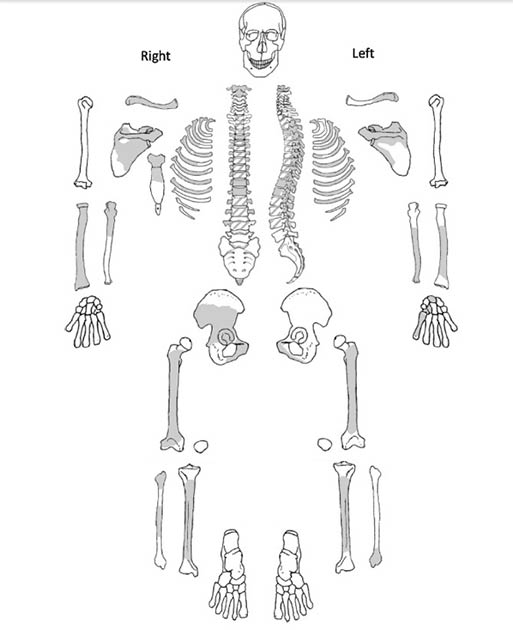
Breakthrough Discovery of Earliest Cancer Case from Bronze Age China
An examination of the skeletal remains of a man from Bronze Age China has produced some astonishing results. Work conducted by the international research team resulted in experts finding one of the earliest examples of cancer in East Asia. Such discoveries are very rare. Potentially this could help specialists to better understand the disease, which is one of the leading causes of death around the globe.
- Researchers Diagnose Earliest Known Cancer on 1.7-Million-Year-Old Hominin Fossil
- Archaeologists Found a Medieval Body with a Tumor That Was Growing Teeth – But That’s Not the Whole Story
- Pancreatic Cancer Treated With Ancient Chinese Medicine
The remains that were examined in the study came from a man who belonged to the Qijia material culture that dated from about 1750 to 1450 BC. We know little about this culture, but it is believed that it was a sedentary culture that practiced agriculture and animal husbandry. The Encyclopaedia Britannica reports that the “Qijia people lived in large villages in terraces along the Huang He (Yellow River) and buried their dead in pits.” The individual was found interred in a cemetery, located in Gansu Province, in the northwest of China.

The skeletal inventory of the remains discovered dating from Bronze Age China. The shaded areas show the present skeletal remains found at the site. (Jenna Dittmar / Science Direct)
Ancient Case of Cancer?
The dead man had been interred in a tomb with six other people. His skeleton was only 60% complete and the man died between the ages of 34 and 44. An international research team examined the skeleton. They wrote in the International Journal of Paleopathology that the “human skeletal remains were assessed macroscopically and radiographically using plain X-rays.”
The experts found multiple small circular lesions on the bones. These were examined and after a process of elimination, they rejected possible causes of the abrasions. They found that they could not be explained by tuberculosis, a fungal infection, or any rare bone condition. This was a difficult process because of the incomplete nature of the remains.

The skeletal remains dating back to Bronze Age China have been analyzed by an international research team. By using a combination of photography and X-rays, they found osteolytic lesions with no sclerosis. They ultimately concluded that these remains are the earliest case of multiple myeloma found to date in East Asia. (Jenna Dittmar / Science Direct)
Mystery Origin of Cancer
Eventually, specialists came to the conclusion that it was a type of cancer and they investigated if the lesions were possibly caused by the leukemia or metastatic carcinoma, but these were ultimately ruled out. The team in the International Journal of Paleopathology stated that “based on the nature, distribution, and radiographic appearance of the lesions, the most likely diagnosis is multiple myeloma.” This is a malignant cancerous tumor and it appears to have been focused on the marrow of the bones.
Incidences of this cancer have been found from the Stone Age to modern times. This particular type of cancer is quite rare. It is mostly found in rich countries and is associated with unhealthy lifestyles. Multiple myeloma frequently affects the bones and is more common among males. The genesis of this cancer, like so many others, is not known.

Photograph (above) and X-ray (below) of the rib shaft of the ancient Bronze Age man showing osteolytic lesions. (Jenna Dittmar / Science Direct)
Finding Archaeological Cases of Cancer Is a Rarity
In general, finding evidence of cancer in ancient people is very rare. According to the International Journal of Paleopathology, “the evidence of cancer from past populations is rare: less than 300 cases have been identified in the archaeological record.” This makes the discovery of these remains from Bronze Age China and the fact the man had a malignant tumor especially important. It is believed to be one of the earliest examples of cancer found in all of East Asia. There has only been a handful found in the People’s Republic of China. The only other possible case of this disease in the country was found in a male who died 6,000 years ago during the Neolithic period.
The discovery of this melanoma is important. This is because it was found in a geographic area and from a period where none have been previously identified. The researchers stated in Science Direct that finds of this nature are needed “in order to better reconstruct the history and evolution of cancer.”
Understanding the Evolution of Cancer
This study by placing a case of cancer in a specific context can help specialists, greatly. It allows them to understand the nature of this terrible condition in the ancient past and how it afflicted ancient men and women. This discovery can also help them to understand how changing environments impacted on the nature and prevalence of cancers in the past and could help modern specialists to better understand the underlying mechanism that leads to the disease and this could lead to the development of new treatments.
The study, “A probable case of multiple myeloma from Bronze Age China” by J.M. Dittmar, E.S. Berger, R. Mao, H. Wang and H-Y Yeh has been published in the International Journal of Paleopathology.
Top image: Scientists have discovered one of the earliest cases of multiple myeloma, a malignant cancerous tumor, found to date in East Asia within skeletal remains that date back to Bronze Age China. The image shows osteolytic lesions visible on photographs and X-rays of vertebrae. Source: Jenna Dittmar / Science Direct
By Ed Whelan















